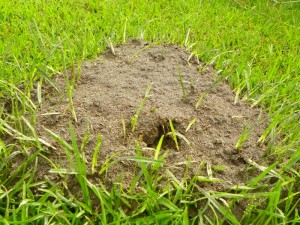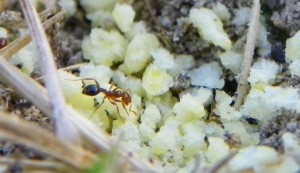Treating for Fire Ants
go.ncsu.edu/readext?224971
en Español / em Português
El inglés es el idioma de control de esta página. En la medida en que haya algún conflicto entre la traducción al inglés y la traducción, el inglés prevalece.
Al hacer clic en el enlace de traducción se activa un servicio de traducción gratuito para convertir la página al español. Al igual que con cualquier traducción por Internet, la conversión no es sensible al contexto y puede que no traduzca el texto en su significado original. NC State Extension no garantiza la exactitud del texto traducido. Por favor, tenga en cuenta que algunas aplicaciones y/o servicios pueden no funcionar como se espera cuando se traducen.
Português
Inglês é o idioma de controle desta página. Na medida que haja algum conflito entre o texto original em Inglês e a tradução, o Inglês prevalece.
Ao clicar no link de tradução, um serviço gratuito de tradução será ativado para converter a página para o Português. Como em qualquer tradução pela internet, a conversão não é sensivel ao contexto e pode não ocorrer a tradução para o significado orginal. O serviço de Extensão da Carolina do Norte (NC State Extension) não garante a exatidão do texto traduzido. Por favor, observe que algumas funções ou serviços podem não funcionar como esperado após a tradução.
English
English is the controlling language of this page. To the extent there is any conflict between the English text and the translation, English controls.
Clicking on the translation link activates a free translation service to convert the page to Spanish. As with any Internet translation, the conversion is not context-sensitive and may not translate the text to its original meaning. NC State Extension does not guarantee the accuracy of the translated text. Please note that some applications and/or services may not function as expected when translated.
Collapse ▲Recent rains have increased fire ant activity in the region. While there is no way to rid a location of fire ants permanently, there are many products available for managing them. Options include drenches, granules, and baits. Drenches and granules give the quickest results, but baits provide the most effective control over the long run.
Ant Control Products
Drench, granule, and bait fire ant control products are available with organic as well as synthetic active ingredients, though products containing organic ingredients are more difficult to find. Most fire ant control products are labeled to use in lawns, with fewer products labeled for vegetable gardens. Check product labeling before use to make sure the product you plan to use can be applied where you need it and for safety information regarding people, pets, and wildlife.
Drenches are mixed with water and poured onto a mound. They provide quick knock down of the mound but rarely kill all of the ants and new mounds usually pop up in the treated area within a few days. Drenches are useful when a mound needs to be quickly neutralized, but not for treating a large area. Most drench products contain synthetic insecticides like bifenthrin or permethrin. The Safer brand of products offers an organic drench with the active ingredient D-limonene, but this may be difficult to find locally.
Granules are sprinkled around a mound or broadcast over the yard. Ants are killed when they come in contact with the pesticide. Granules usually do a better job of killing more ants than drenches but rarely get them all. Most granular products contain either bifenthrin, permethrin, or a similar synthetic insecticide.
Baits are Best
Baits are insecticides designed to fool pests into thinking they are food. When applied correctly, baits are the most effective, long lasting, and environmentally friendly method of fire ant control available. Baits can be applied around individual ant mounds or broadcast over a large area. Broadcasting is recommended when there are more than five mounds visible per quarter acre or over 20 mounds per acre. When applied correctly, broadcasted baits only need to be put out once or twice a year to provide excellent control of fire ants.
Baits should be applied when fire ants are actively foraging for food. During summer, ants forage most prolifically in the cooler hours of early morning and late evening. For best results apply baits in the morning after the dew has dried on a day when rain or irrigation is not expected for at least 24 hours. If you are treating individual mounds, spread bait around the perimeter of the mound, taking care to disturb the mound as little as possible. Always use fresh baits since the soybean oil used in baits can spoil over time. Read the label directions of any product you are thinking about using to find out what rate it should be applied and how it should be spread.
The most commonly available bait contains the synthetic insecticide hydramethylnon and is sold as Amdro Fire Ant Bait. If you prefer to use organic products, look for baits that contain spinosad as the active ingredient. Brand names of baits that contain spinosad include Ferti-lome Come and Get It, Green Light Fire Ant Control with Conserve, and Safer Fire Ant Bait. All of these products begin killing ants within a few weeks of application, though their full effectiveness is not realized for several weeks.
Some newer products, like Amdro Fire Strike and Extinguish Plus, contain both the synthetic insecticide hydramethylnon, as well as an insect growth regulator. Insect growth regulators work differently than chemical insecticides, by preventing insects from developing rather than killing them immediately.
Insect growth regulators, which include (S)-methoprene and abamectin, are extremely safe and are one of the few types of ant control products that can be used in agricultural lands, including vegetable gardens and pastures. They are very effective in the long term, but take three to four months to reduce ant populations. Since brand names change constantly, be sure to check the active ingredient listings before you purchase any pesticide to make sure you are getting the product you want.
Please Note: Any recommendations of brand names or listing of commercial products in this article are included solely as a convenience to the reader and do not imply endorsement by N.C. Cooperative Extension nor discrimination against similar products. Before applying any chemical, always obtain current information about its use and read the product label carefully.
Learn More
To find out more about managing fire ants visit the North Carolina State Extension website, https://content.ces.ncsu.edu/red-imported-fire-ant-in-north-carolina#:~:text=Fire%20ants%20are%20native%20of,areas%20in%20western%20North%20Carolina., as well as Texas A&M’s fire ant website: http://fireant.tamu.edu/
Find listings of fire ant control products by brand name and active ingredient from this Extension resource:
For specific information on controlling fire ants in the vegetable garden, see these sites:
- Clemson Extension: http://www.clemson.edu/extension/hgic/plants/vegetables/gardening/hgic1263.html
- Mississippi Extension http://extension.msstate.edu/content/control-fire-ants-and-around-home-vegetable-gardens
For sustainable fire ant management options, see this website: https://sfyl.ifas.ufl.edu/lawn-and-garden/sustainable-fire-ant-control/
Visit your local Cooperative Extension office to learn more about gardening and landscape care. Go to https://www.ces.ncsu.edu/local-county-center/ to find your county Extension center.





